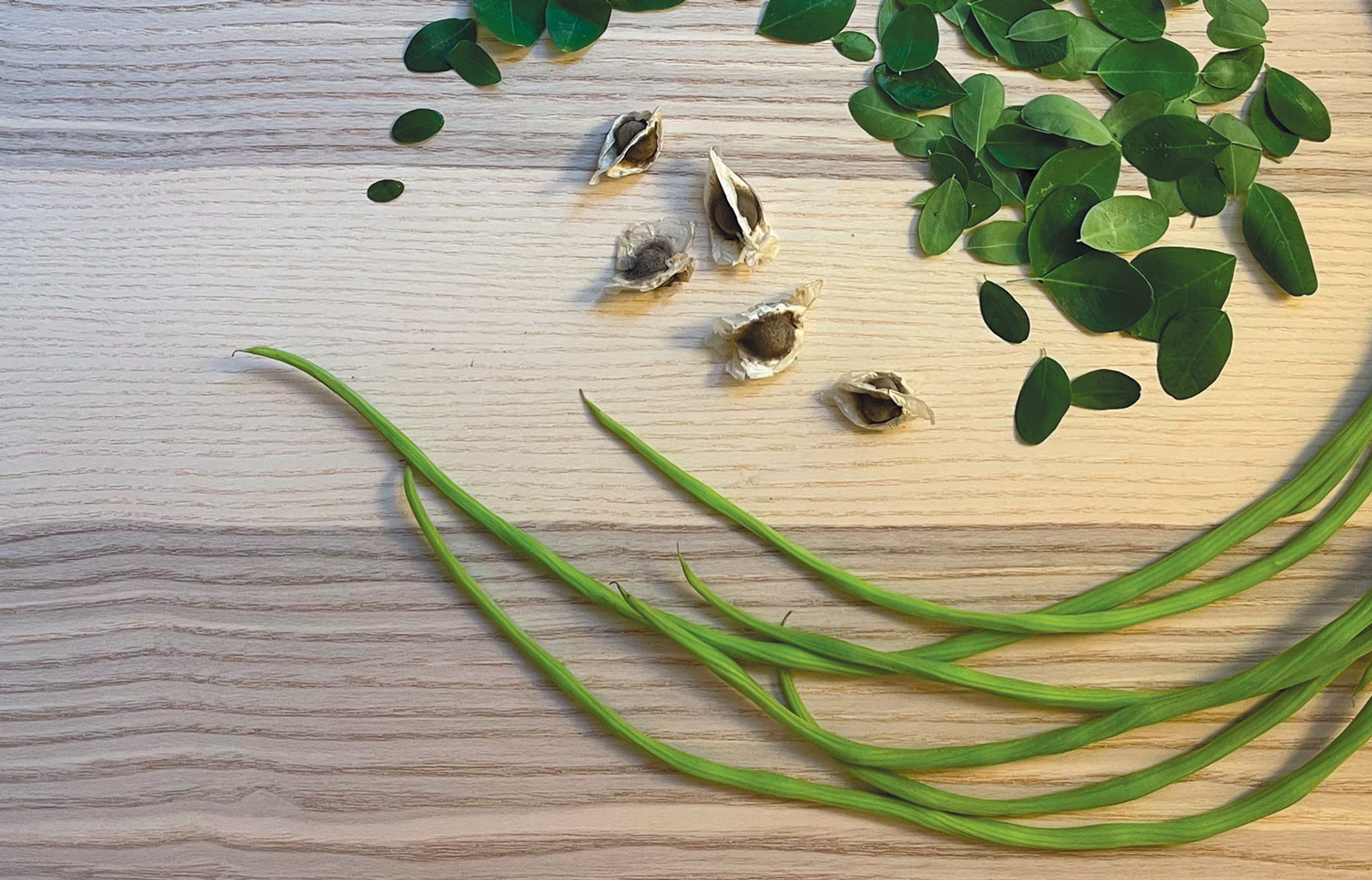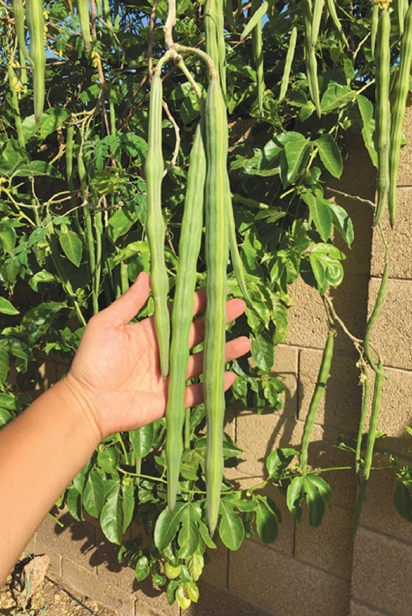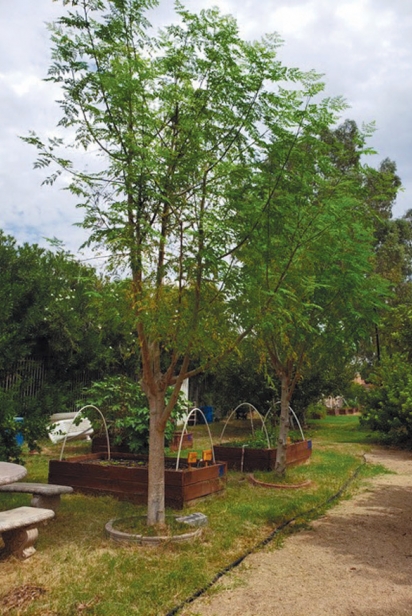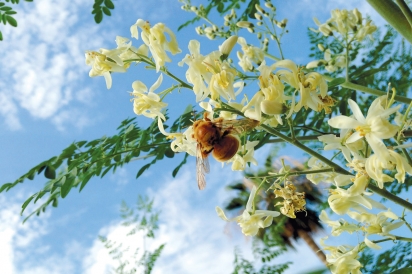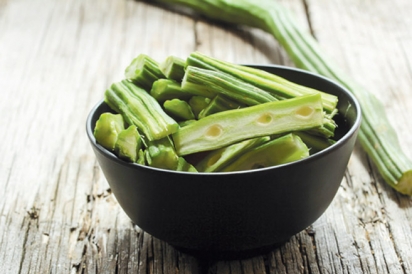Moringa: Can a Superfood Become a Climate Hero?
EVERY FEW YEARS or so, as nutrition researchers make diet-related advances, we learn of a new “superfood” to include in our diets to maintain optimal health. Acai berries, salmon, kale, chia seeds, green tea and soybeans are a few that come to mind.
Currently, Moringa oleifera holds the spotlight.
Hailed as a miracle food by researchers, nutritionists and healthy-food purveyors, it made the Top Wellness Trends list on “Good Morning America” in 2018. According to University of California records, sales are growing rapidly: 85% year over year. Moringa appears as an ingredient in all manner of nutritional supplement formulas, in tea blends, in rice noodles, even in ice cream. I found dried whole-leaf moringa in the Mexican seasoning section of my grocery store.
But could moringa be more than a superfood and actually help mitigate the effects of climate change? In today’s world where droughts, floods, crop failures and uncertain harvests increasingly threaten the global food supply, we need to identify easy-to-grow foods that tolerate extreme temperatures, use less water and pack a full array of nutrients. The moringa tree may be just such a candidate.
There are many species of moringa, most of which are native to Africa, but not all are edible.
Moringa oleifera originated in India, and its leaves, pods and seeds have been consumed for centuries in equatorial regions of Southeast Asia and in the Philippines. It is drought tolerant and adaptable to hot, sandy deserts. It is widely grown in Kenya and other east African countries where it is a valuable cash crop, and, under changing climate conditions, it is more dependable for farmers to grow than maize.
Moringa oleifera has pretty, delicate, pinnately compound leaves, somewhat like those of a locust tree. It loves the intense sun and can grow many feet in a season, so it benefits from extensive pruning. It grows fast to maturity in five years, then it slows down. With careful pruning, by its second or third year of growth it can provide ample shade for other plants in a garden. Moringa has a life-span of about 15—20 years.
Its leaves, flowers and seedpods [the large mature versions are called drumsticks or drummies] provide tasty, nutritious food with high concentrations of protein, vitamins, minerals and phytonutrients. Oil can be extracted from the seeds and used for cosmetics, or as a lubricant (not for cooking) and the leftover ground seed “cake” can be used to clarify muddy water. The leaves can also be fed to farm animals like goats, pigs and chickens. It truly does seem like a miracle plant, gaining in renown and worldwide production just in time to offset the dire effects of increasing drought and food insecurity.
Moringa in the Valley
Moringa oleifera initially found its way to Phoenix about 10 years ago. While gaining much media attention at the beginning, resources for seedlings or seeds were scarce. Today it is catching on among food gardeners in the Valley who recognize its value as a food source, a shade tree and a pollinator attractor that is suitable for our hot desert climate and scarce water resources.
Dionne Washington, co-founder of Project Roots with Bridget Pettis (a Phoenix Mercury WNBA star and coach), is a big fan of moringa. “We use the leaves to make a nutritional powder supplement. This moringa supplement can sustain one for a day, it is so nutritious.” They have planted 50 trees at Spaces of Opportunity, their co-op farm and community garden at 19th Avenue and Vineyard. In a couple of years, she says, they will be able to harvest enough leaves to produce the powder commercially.
Morgan Winburn, who manages the Escalante Garden and the Clark Park in Tempe for the Tempe Community Action Agency (TCCA), grows moringa, which she calls “a miracle plant that looks dead but then comes back to life.” She tells me that because moringa has a deep taproot and does not spread its root system out under the canopy, it can be planted close to buildings to provide shade on walls without harming the foundation. Even a little patch of shade around a house can lower temperatures significantly. In urban areas with few trees, the moringa tree might help reduce the heat island effect that is increasingly exacerbated by rising temperatures, drought and urban expansion.
Greg Peterson, of The Urban Farm, has grown a couple of moringa trees in his fruit forest for five years now. Because he uses flood irrigation, the trees could overtake his garden, so he planted them in a corner. “They are voracious growers and with lots of water will reach 30—50 feet in height if you don’t prune them back. Their structure is like a mulberry tree, and the wood is soft, like balsa wood.”
Mark Rhine of Rhiba Farms has grown moringa for 14 years and has 100 trees at his farm in San Tan Valley. Some he lets grow without harvesting or pruning, and with drip irrigation they grow very tall and provide shade for parts of his farm. “They attract the bees, the birds and the butterflies,” he says.
Suzanne Vilardi of Vilardi Gardens, an organic plant nursery, says that moringa trees offer protection from wind and sun for delicate plants or berry bushes. “They are part of the permaculture guild, and great nurse trees for chiltepine bushes, for example.” Other growers recommend the moringa as a shade tree for young avocados and tropical fruits like mango, sapote, pineapple guava and loquat trees.
Growing the Trees
Peterson says, “As an edible shade tree, it is absolutely a good contribution to a garden or food forest here in the desert—if it grows in the heat, grow it!”
While there is variation in plants and growing characteristics, moringa can be grown from seed quite easily. Peterson tells me that a tree can also take root from a branch cutting as long as it is well watered.
Rhine prefers to grow the trees from seed. “I save seed from mature pods for propagation. It is best to grow moringa from seed. You get a hardier tree that will be more productive.” He soaks the seeds for about a week until they sprout, then plants them in pots. Young trees are for sale at the farm.
Moringa is frost sensitive, especially when young, so in the Valley it is best not to plant moringa in winter. Young trees need to be protected by insulating the trunks from freezing temperatures, and mulching deeply over the base of the tree, or they will die back to the ground. They will most likely re-emerge come spring, but the setback in growth means lower leaf production.
Moringa generally blossoms from April to December in the Valley. In spring and fall the long, young seedpods can be eaten as a vegetable, like asparagus. The leaves can be harvested all season long. The tree sheds its leaves and becomes dormant in the dark winter months. The shed leaves provide good mulch and soil nutrients.
Like any food plant or fruit tree, moringa takes some work. There are many YouTube videos online showing how gardeners care for their moringa trees.
Peterson uses a pruning technique called “pollarding” to encourage bushy growth. It entails cutting all the tree branches off and leaving a trunk about five to eight feet tall, from which new branches grow profusely and compactly. “This yields a lot of leaf production, and greens for eating,” he says.
Cooking and Eating Moringa
Jacq Davis has grown moringa for years in her lush permaculture food forest that she and her husband call Epic Yard Farm. An avid cook, she makes use of all the edible parts.
She prefers to eat the leaves fresh in soups, stews, smoothies, juices and salads. But as other growers do, she also dries them for tea, or grinds them up into a powder for seasoning or as a food supplement. She gathers leafy branches and hangs them to air-dry in a dark, well-ventilated place. Then she grinds them into powder to add to soups, smoothies, or sprinkled as a seasoning.
Davis says, “I also eat the very young, long seedpods when they are lush and green, no bigger around than my index finger. I peel the ridges off, cut them into two-inch lengths and cook them in stir-fries, or a dry curry, as the East Indians do. They have a mustardy flavor—they are part of the brassica family.
You can also eat the seeds at this stage when they are pale in color, not brown. Peel off the skins and use them like edamame.” But a caution here from Davis: “If not accustomed to eating moringa, it is best to try out a very small amount to see if it agrees with you.” Because of their laxative effect, too much of the oily seed can upset the stomach and digestive system.
The flowers, available all season long, are said to be like mushrooms in texture and flavor. Davis sautés them in ghee with onions, and adds them to frittatas, omelets and stir-fries.
Winburn cooks the pods like asparagus. “I sauté them in butter, then drizzle them with balsamic vinegar. Delicious!”
Rhine says, “I harvest the leaves weekly from May to November and sell them by the bunch at the Saturday farm stand, and at Gilbert Farmers Market.” He also sells the flowers which he recommends for tea and salads, and the tender young seedpods which follow the bloom on second year growth.
He likes to pickle the seedpods, as one would for green beans. “They are spicy, so they don’t need hot pepper in the brine,” he says.
Nutritional Values
Carrie Waterman, a natural-products chemist at UC Davis funded by an NIH Fogarty International Center Grant, has researched the nutritional components of moringa as well as optimal farming and processing protocol to ensure the highest nutrient retention. Waterman first discovered moringa as a Peace Corps volunteer in Kenya, where she ate it and helped grow it in community gardens. She holds a patent for processing the plant and consults with growers in Kenya and elsewhere on best cultivation and processing techniques.
According to Waterman, the leaves are protein-packed and contain all the essential amino acids, iron, copper, zinc, potassium and magnesium. The flowers are rich in calcium, potassium and amino acids, while the pods supply protein in addition to vitamin C and calcium. The USDA nutritional database, Food- Data Central, provides breakdowns for both the leaves and the drumsticks.
Coming to a Neighborhood Near You
As for the future of moringa in the Valley, Winburn is finding that “there is new interest and a resurgence in growing moringa; people are interested in using less water in their landscapes, seeking plants that are fast growing and shade producing.”
Washington says, “At some point we may not have access to fresh fruits and veggies. Our mission is to teach people how to grow food, and moringa can be a part of that.”
While moringa’s gastronomic merit is not yet well-established, surely it will develop and give rise to more food, more shade, more greenery in hot desert cities. As Carrie Waterman states, “if there were a top 10 list of plants that are going to help feed the world over the next 100 years, I would say moringa should be on that list.”
Where to Buy Moringa Plants
They will be available in the spring at:
Vilardi Gardens
Vilardi sells at Roadrunners Farmers Market
(3602 E. Cactus Rd., Phoenix) on Saturdays.
She also supplies all Summer Winds nurseries in the greater Phoenix area. Call ahead.
vilardigardens.com
Moringa Tree of Life, Tucson
Mail order at moringatreeoflife.com
Rhiba Farms
The farm stand is open on Saturdays from 8am to noon.
40792 N. Rattlesnake Rd., San Tan Valley
rhibafarms.com


